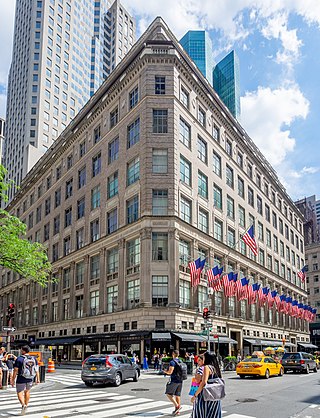
Saks Fifth Avenue is an American luxury department store chain founded by Andrew Saks and headquartered in New York City. The original Saks opened in the F Street shopping district of Washington, D.C. in 1867. Saks expanded into Manhattan with its Herald Square store in 1902 and flagship store on Fifth Avenue in 1924. The chain was acquired by Tennessee-based Proffitt's, Inc. in 1998, and Saks, Inc. was acquired by the Toronto-based Hudson's Bay Company in 2013. With the establishment of HBC's American division Saks Global in 2024, it is sister brands with department stores Bergdorf Goodman and Neiman Marcus. Saks Off 5th, originally a clearance store for Saks Fifth Avenue, is now a large off-price retailer in its own right.

Fifth Avenue is a major thoroughfare in the borough of Manhattan in New York City. The avenue stretches southward from West 143rd Street in Harlem to Washington Square Park in Greenwich Village. The section in Midtown Manhattan is one of the most expensive shopping streets in the world.

Parisian Inc. was an American chain of upmarket department stores founded and headquartered in Birmingham, Alabama. Competing mainly through the 1980s against Nordstrom, Neiman Marcus, and Gus Mayer, Parisian underwent a series of restructurings and mergers during its 130-year history, and was taken over by Proffitt’s, Inc. in 1996. In September 2006, Belk purchased Parisian from Saks for $285 million with twenty-four locations later becoming Belk by September 2007. Belk sold four stores in Michigan, Indiana, and Ohio to The Bon-Ton in October 2006. Bon-Ton operated these stores individually under the Parisian name until 2013 when the exclusive marketing rights to operate under the Parisian name expired, marking the end of this upmarket department store.
Marshall Field & Company was an upscale department store in Chicago, Illinois. Founded in the 19th century, it grew to become a large chain before Macy's, Inc, acquired it in 2005. Its founder, Marshall Field, was a pioneering retail magnate.

Lord & Taylor was the oldest-surviving department store chain in the United States. The company operated full-line department stores from 1826 until it filed for bankruptcy in 2020. The following year, in 2021, it closed all its brick-and-mortar stores. Saadia Group acquired the Lord & Taylor intellectual property and relaunched the e-commerce website later that same year. However, due to financial challenges, Saadia went into default in March 2024. In September 2024, Regal Brands Global acquired the Lord & Taylor intellectual property.
S. H. Kress & Co. was the trading name of a chain of five and dime retail department stores in the United States established by Samuel Henry Kress. It operated from 1896 to 1981. In the first half of the 20th century, there were Kress stores with ornamented architecture in hundreds of cities and towns.

Gimbel Brothers was an American department store corporation that operated for over a century, from 1842 until 1987. Gimbel patriarch Adam Gimbel opened his first store in Vincennes, Indiana, in 1842. In 1887, the company moved its operations to the Gimbel Brothers Department Store in Milwaukee, Wisconsin. It became a chain when it opened a second, larger store in Philadelphia, Pennsylvania, in 1894, moving its headquarters there. At the urging of future company president Bernard Gimbel, grandson of the founder, the company expanded to New York City in 1910.
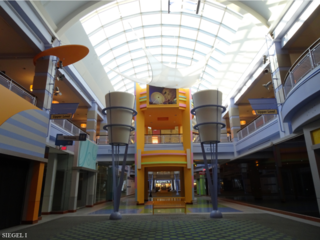
Forest Fair Mall is an abandoned enclosed shopping mall in the northern suburbs of Cincinnati, Ohio, United States. It is situated on the border between Forest Park and Fairfield, at the junction of Interstate 275 and Winton Road. The mall, built in phases between 1988 and 1989 as Forest Fair Mall, has become noted for its troubled history; despite being the second-biggest mall in the state and bringing many new retailers to the market, it lost three anchor stores and its original owner LJ Hooker to bankruptcy less than a year after opening. The mall underwent renovations throughout the mid 1990s, attracting new stores such as Kohl's, Burlington Coat Factory, and Bass Pro Shops. Mills Corporation renamed the property to Cincinnati Mills in 2002 and renovated the mall once more in August 2004. Following the sale of Mills's portfolio to Simon Property Group, the mall was sold several times afterward, while continuing to lose many of its key tenants. After having been renamed to Cincinnati Mall and again to Forest Fair Village in the 2010s, the property received significant media attention as an example of a dead mall. It also received a number of proposals for renovation, none of which were realized. Following years of tenancy decline, it closed to the public on December 2, 2022 with the exception of Kohl's and Bass Pro Shops. Bass Pro Shops closed on January 13, 2024. On January 9, 2025, Kohl's, the final store, announced its upcoming closure.

Bonwit Teller & Co. was an American luxury department store in New York City, founded by Paul Bonwit in 1895 at Sixth Avenue and 18th Street, and later a chain of department stores.

The Fashion Center is a shopping center located in Paramus, New Jersey. It opened in 1967 as a traditional indoor shopping mall. The mall slowly underwent a "de-malling" process over a period of several years prior to 2009, which resulted in the former interior portion of the mall gradually taken over by other stores and eventually sealed off, with each store inside the center having its own outside entrances.

Americana Manhasset is an upscale, open-air shopping mall located in the Strathmore area of Manhasset, in Nassau County, on Long Island, in New York, United States. At roughly 220,000 square feet (20,000 m2) in area and approximately 1,500 feet (460 m) in length, it is located along – and anchors – a stretch of Northern Boulevard commonly referred to as the "Miracle Mile" of Manhasset.

North Star Mall is a shopping mall in San Antonio, Texas, USA with anchor tenants Dillard's, JCPenney, Macy's, Saks Fifth Avenue, and Forever 21. It also has over 200 specialty stores, some exclusive to the San Antonio market, including Armani Exchange, Build-A-Bear Workshop, MAC Cosmetics, and Oakley. The mall, which opened in 1960, is located at the intersection of Loop 410 and San Pedro Avenue in the city's Uptown District. It is a well-known city landmark for its Texas-sized cowboy boots, created by Texas artist Bob "Daddy-O" Wade, that are located along its Loop 410 frontage.
Best & Co. was a department store founded in 1879 by Albert Best in New York City. The company initially sold clothing for infants and children, but later expanded to women's clothing and accessories. It was known for its "tastefully styled and proper women's clothes and its sturdy children's wear." Philip Le Boutillier served as president during the late 1930s. The store had expanded to 20 branches by 1966, when the company was acquired by McCrory's, who also operated Lerner Shops and S. Klein. In late-1970, McCrory's liquidated the company. At the time of its closing, the store had 1,200 employees.
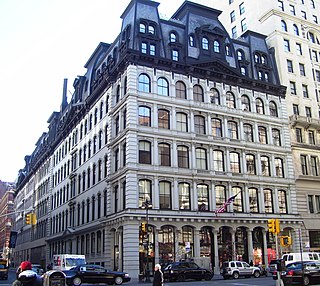
Franklin Simon & Co. was a New York City-based department store chain specializing in women's fashions and furnishings. The store was conceived as a collection of specialty shops rather than a traditional U.S. dry goods store. Each "shop" had a specialty product line, such as ready-to-wear apparel for women, misses, girls, boys, men, young men and infants. When the chain closed in 1979, there were 42 stores.
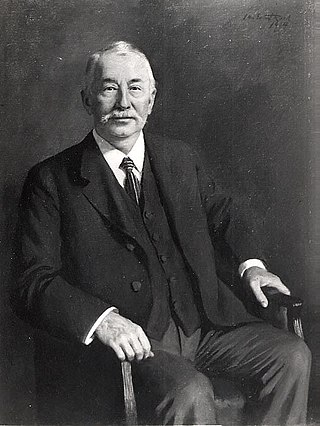
Benjamin Altman was a New York City department store owner and art collector who is best known today for his large art collection, which he donated to the Metropolitan Museum of Art.

Sakowitz was a men's clothing store which grew into a small chain of family-owned high-end department stores based in Houston, Texas. It operated from 1902 until 1990. Sakowitz was responsible for launching many of the now-famous European fashion designers in America - among them Andre' Courreges, Yves St. Laurent Rive Gauche, Zandra Rhoades, Givenchy, and Erminegildo Zegna. The Sakowitz catalogues were mailed to all fifty states and abroad.

The Ladies' Mile Historic District was a prime shopping district in Manhattan, New York City at the end of the 19th century, serving the well-to-do "carriage trade" of the city. It was designated in May 1989, by the New York City Landmark Preservation Commission to preserve an irregular district of 440 buildings on 28 blocks and parts of blocks, from roughly 15th Street to 24th Street and from Park Avenue South to west of the Avenue of the Americas. Community groups such as the Drive to Protect the Ladies' Mile District and the Historic Districts Council campaigned heavily for the status.
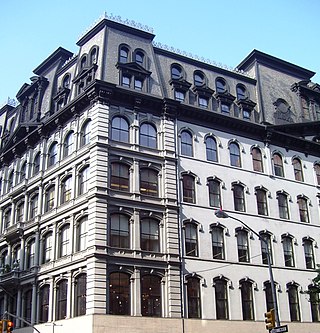
Arnold Constable & Company was a department store chain in the New York City metropolitan area. At one point it was the oldest department store in America, operating for over 150 years from its founding in 1825 to its closing in 1975. At the company's peak, its flagship "Palace of Trade" in Manhattan – located at 881-887 Broadway at East 19th Street, through to 115 Fifth Avenue – was acknowledged to be the store which took the largest portion of the "carriage trade", in New York, serving the rich and elite of the city, such as the wives of Grover Cleveland, Andrew Carnegie, Thomas Edison, J.P. Morgan, John D. Rockefeller and Cornelius Vanderbilt.
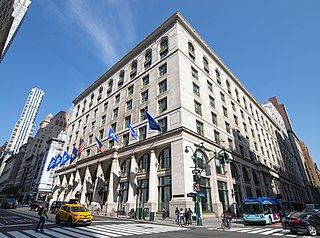
The B. Altman and Company Building is a commercial building in Midtown Manhattan in New York City, that formerly served as B. Altman and Company's flagship department store. It occupies an entire city block between Fifth Avenue, Madison Avenue, 34th Street, and 35th Street, directly opposite the Empire State Building, with a primary address of 355–371 Fifth Avenue.

390 Fifth Avenue, also known as the Gorham Building, is an Italian Renaissance Revival palazzo-style building at Fifth Avenue and West 36th Street in the Midtown Manhattan neighborhood of New York City, United States. It was designed by McKim, Mead & White, with Stanford White as the partner in charge, and built in 1904–1906. The building was named for the Gorham Manufacturing Company, a major manufacturer of sterling and silverplate, and was a successor to the former Gorham Manufacturing Company Building at 889 Broadway. The building features bronze ornamentation and a copper cornice.


























